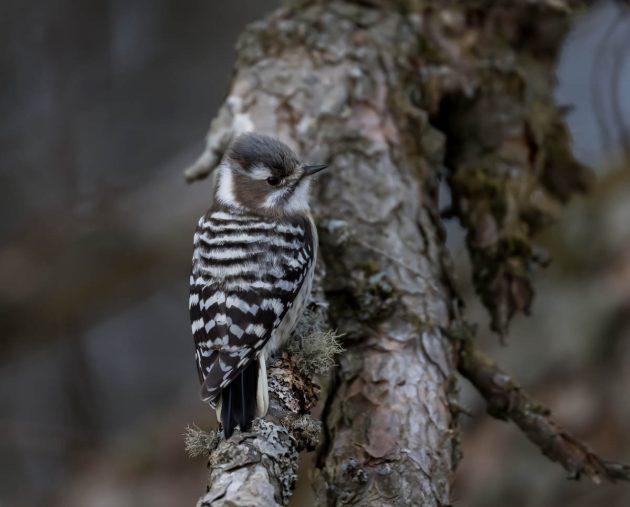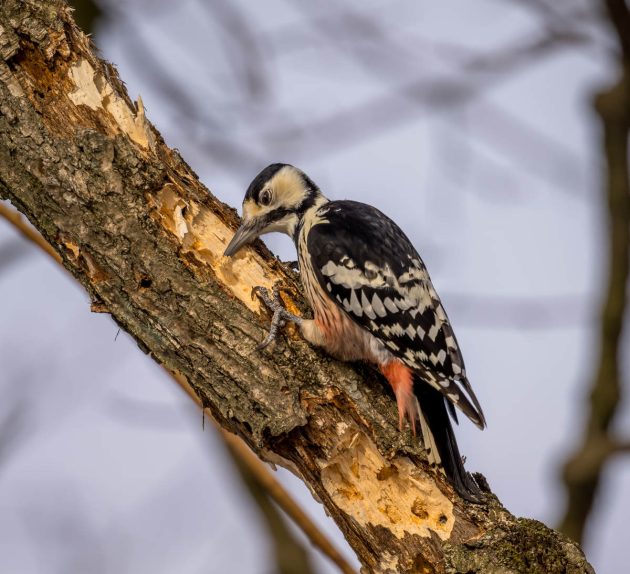A Japanese book on Hokkaido birds lists 6 species of woodpeckers – I saw three of them, presumably the most common ones.
The most interesting of the three (at least to me) is the Japanese Pygmy Woodpecker. While the name suggests an endemic, it is not – it can also be found in Northeastern China, parts of Russia and the Koreas (though I would probably advise against a birding trip to North Korea).
At least its scientific name kizuki sounds very Japanese to me. It supposedly is based on the Japanese name for woodpecker, Kizuki (= Kitutuki < ki wood; tutuki pecking), though the HBW sounds like it is not entirely convinced of this explanation.

Give researchers an expensive toy such as a Scanning Electron Microscope, and they will use it on anything at hand. The result might be a paper such as this one: “Scanning Electron Microscopic Study of the Tongue in the Japanese Pygmy Woodpecker“. Which features exciting sentences such as “The dorsal surface of the lingual body presented smooth aspect and in both lateral sides of the root of the lingual body, a pair of openings of the lingual glands was observed.”

While Japanese Pygmy Woodpeckers still excavate their nest holes, they are not very good at it (a paper puts it more politely and talks of “weak excavation capabilities”). The solution: use trees with soft wood, or even rotten trees (same source). If even that is too much work, find a hole already occupied by another Japanese Pygmy Woodpecker pair and kick them out (source: HBW).

Indeed, the species seems quite adaptable to changing environmental conditions. In some areas, they have apparently realized that drumming on metal creates a better (maybe louder?) sound than drumming on wood, and now prefer to drum on metal telephone poles or plates (source). This also helps when trees are felled. Moreover, at least in one individual observation, a bird seems to have carefully selected the point of a metal plate that creates the highest-pitched sound (source).

In contrast, the Great Spotted Woodpecker is described as a strong excavator. And this is reflected in its choice of trees – no “prey on the weak and decaying”, but rather a preference for large trees (median diameter at breast height: 50 cm), high above the ground (median 11 m), and mostly in living trees (source).

Can you tell the sex of a Great Spotted Woodpecker by its drumming pattern? For example, is there the equivalent of a “mansplaining” drum pattern only used by the males? One paper says no.

Though that is a bit disappointing, the paper still delights with the rare occurrence of humor in a scientific abstract. Specifically, the abstract starts with the sentence “Animals—including conservation biologists—use acoustic signals to recognize and track individuals.”

Some of the ecological importance of the Great Spotted Woodpecker comes from its role as a real estate developer, fortunately without the debt problems that currently plague the Chinese companies taking up this role in the human world. One study on Hokkaido found that 47 out of 110 old woodpecker holes were used by renters, which in the biological world are called secondary cavity users. And as in the human world, the suitability of these holes decreases with time (presumably some of the really old ones do not even have wifi yet).


At first glance, the White-backed Woodpecker to me looks very similar. Granted, it is a bit bigger, but not by much. One distinction is described here.

Similar to the Great Spotted Woodpecker, male White-backed Woodpeckers have a red crown, so conservation biologists do not have to rely on drumming patterns for sex determination (homework: which of the photos of the species here show a male?)


If you care for beetles rather than for woodpeckers, you might still be interested in protecting the bird. One study found that “if the White-backed Woodpecker can be saved in Finland, a suite of threatened saproxylic beetles will most likely be saved as well.” The logic behind this is that both the beetles and the woodpecker species depend on the same resource, decaying wood.

If you want to impress somebody with this information, make sure to use the term “umbrella species” – it will immediately lend you an air of profound expertise.

But of course, many forests are not protected, and thus their habitat quality declines. One paper describes an interesting approach to monitoring this decline. It looks at the feather growth bars of current and old museum specimens – apparently, wider bars indicate better living conditions and thus habitat quality. And indeed, this shows that the White-backed Woodpecker‘s habitat quality in Sweden declined.


(Another term to impress people: Ptilochronology is the study of the growth rates of feathers by the measuring of growth bars. However, if I were to use that term, I would probably have to practice the pronunciation a few times to avoid any embarrassing mistakes).


Source link

